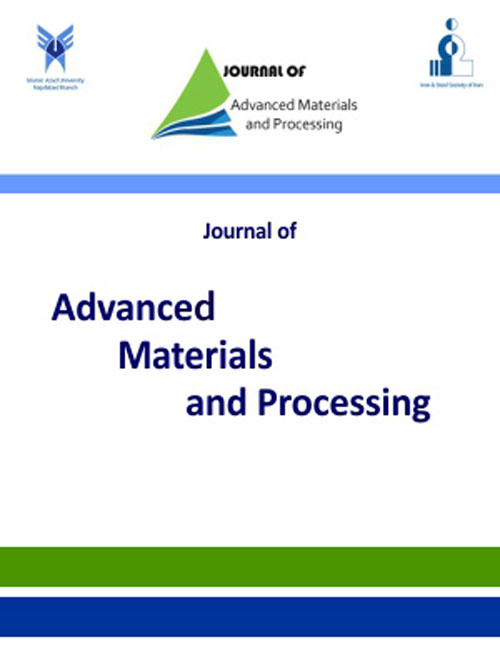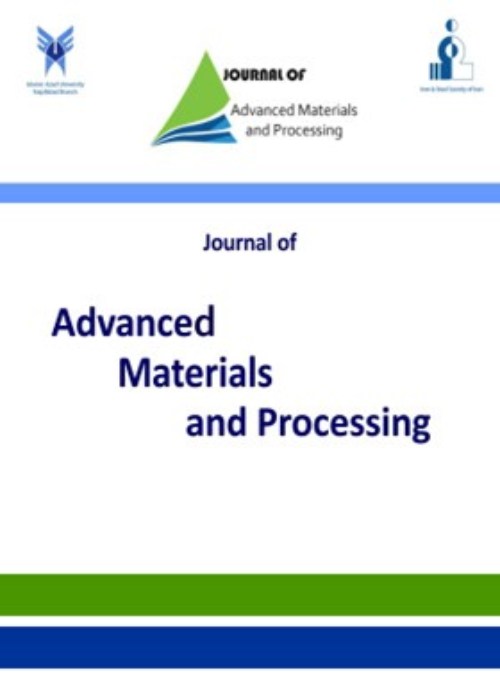فهرست مطالب

Journal of advanced materials and processing
Volume:6 Issue: 2, Spring 2018
- تاریخ انتشار: 1397/01/08
- تعداد عناوین: 8
-
-
Pages 3-11In this research, ZnO nanoparticles (NPs) were synthesized using a binary Zn(II) Schiff-base complex. The complex heat-treated to prepare ZnO nanoparticles via thermal decomposition route at a temperature of 500 °C. The formation of single-phase ZnO nanoparticles and their microstructures were studied by XRD pattern, SEM and TEM observation. The photo-degradation characteristic of the as-prepared ZnO NPs was evaluated and acid blue 193 was investigated as the organic colorant in a photocatalytic reactor by advanced oxidation process (AOP). The effects of operating parameters such as initial concentration of the dye, amount of catalyst and the pH value of the solutions were studied to determine the optimum condition of the process to improve the photo-degradation performance. According to the results, impressive photo-degradation of acid blue is conceivable by the as-synthesized ZnO NPs. The optimum operating conditions to achieve photo-degradation were found to be a solution with pH value of 6, the catalyst concentration of 0.04 g/L, and the dye concentration of 10 g/L. The highest efficiency would be achieved at natural pH of the solution (pH=~6). The optimum concentration of ZnO NPs is about 0.04 g/L. More or less amount of the photocatalyst could not enhance the photodegradation efficiency. At the constant photocatalyst concentration, any increase in dye amounts leads to decrease in degradation efficiency.Keywords: ZnO nanoparticles, Decolorization efficiency, Acid blue 193, Advanced oxidation process
-
Pages 12-23In order to improve the oxidation resistance of ferritic stainless steel, it is possible to deposit a protective coating on steel substrate. In this research through the usage of pack cementation method a coating of titanium was applied on the surface of AISI 430 stainless steel. Scanning Electron-Microscopy (SEM), Energy- Dispersive X-ray spectrometry (EDAX) and X-ray diffraction (XRD) were used for evaluating of coating structure. Results showed that titanium coating consisted of two layers with the total thickness of 50 micron. The titanized layer consisted of TiFe, TiFe2 and Fe2TiO5 phases. For investigating the oxidation behavior of coated and uncoated specimens, isothermal and cyclic oxidation tests were performed at 1000 C. In isothermal oxidation, the oxidation resistance of the titanium coated specimens was improved by restricting the outward penetration of chromium cation. The results of cyclic oxidation of titanium coated samples indicated that they were resistance to lamination and cracking.Keywords: AISI 430 stainless steel, Titanium, Pack cementation, Oxidation
-
Pages 24-33In this study electrical discharge process was used to increase surface wear resistance of pure aluminum. Pulse-on-time and pulse current were considered as input parameters of the electrical discharge process. Experimental results reveal that the electrical discharge process is a successful method for improving the surface wear resistance of aluminum, so that this method has greatly increased the surface wear resistance of aluminum parts. Results indicate that with increase input parameters (pulse-on-time and pulse current) weight loss of the aluminum specimens is reduced and the wear resistance increases. The XRD analysis demonstrated that Al3Ni2 and AlCu intermetallic compound and Al4C3 were formed on alloyed surface. The presence of these compounds and hard particles at the surface increases the wear resistance. Also, friction coefficient measurements show that, after electrical discharge process and improving surface wear resistance, the friction coefficient slightly increased due to the presence of hard particles on the alloyed surface.Keywords: Wear resistance, Electrical discharge Process, Aluminum, Monel 400
-
Pages 34-46Wound dressing applications of nanofibers is a progressive filed of research which could be enhanced by using medicinal plant extract to bring some more advantages. Here we optimized the electrospinning method for fabrication of polycaprolactone-gelatin mixed with a medicinal plant extract, calendula offlcinalis. Characterization techniques including Fourier-transform infrared spectroscopy (FTIR), scanning electron microscope (SEM), Atomic force microscopy (AFM), and contact angle analysis were performed on the electrospun nanofibers to achieve the best formulation proper for wound dressing. In results, the concentration 12 % (W/V) with applied voltage of 20 KV and 13 cm of distance between needle and collector, does poses the lowest diameters with highest porosity among others. The hydrophilicity of the nanofibers was enhanced by adding the calendula extract. In addition, the analysis of mechanical strength showed that the elasticity of PCL/Gelatin/Calendula nanofibers are still acceptable. Overall, the results of characterization tests were approved that the electrospun nanofibers of PCL/Gelatin/Calendula does have appropriate characteristics to be used as wound dressing and could be suggested to clinicians.Keywords: nanofiber, Gelatin, polycaprolactone, calendula offlcinalis, wound
-
Pages 47-58In this study, the effects of passes number and cooling during friction stir processing (FSP) on the microstructure and properties of AZ31 magnesium alloy has been investigated. The process was carried out at tool rotational speed, transverse speed and tool tilt angle of 1100 rpm, 52 mm/min, and 3°, respectively. Cooling was performed by water. The microstructure of FSPed samples was explored by optical microscopy, atomic force microscope (AFM), and scanning electron microscope (SEM). Microhardness and tensile tests were used to characterize the mechanical properties of the samples. In addition, wear and corrosion resistance of processed samples were evaluated. Microstructural investigations showed that the cooling process during FSP led to finer and more homogenized grains because of the suppression of grain growth and as a result, hardness and tensile strength were improved. The best properties obtained after 4 passes by an increase in hardness and tension strength equal to 57 and 21%, respectively. In addition, wear characteristics of this specimen was considerably improved and electrochemical tests showed better corrosion resistance due to the decreasing grain size.Keywords: Magnesium alloy, Friction Stir Processing, Microstructure, Mechanical properties
-
Pages 59-71
The effect of SiC content, additives, and process parameters on densification and microstructural properties of pressureless sintered ZrB2– (1–10 wt %) SiC particulate composites have been studied. The ZrB2–SiC composite powders mixed by Spex mixer with 1-2wt% C (added as graphite powder) and CMC have been cold-compacted and sintered in argon environment in the temperature range of 1800–2100ºC for 2hs. The amount of densification is found to increase with sintering duration and by prior holding at 1200-1650ºC for reduction of oxide impurities (ZrO2, B2O3 and SiO2) on powder particle surfaces via the formation of new phases such as ZrSi2 and ZrC in the system. Presence of SiC with average size smaller than that of ZrB2 appears to aid in densification by enhancing green density, increasing C content by erosion of milling media, and inhibiting matrix grain growth. Both of SiC and C appear to aid in reduction of oxide impurities. The shrinkage of samples was measured, and the microstructure of samples was examined using X-Ray Diffraction and scanning electron microscopy (SEM), equipped with EDS spectroscopy. Room temperature mechanical properties were examined. Sintering temperature has a great effect on relative density, porosity, water absorption, hardness, fracture toughness, oxidation resistance, Strength and microstructure of these composites. The highest relative density, (99.65%), was obtained in ZrB2–10wt. %SiC–2 wt. %C composites sintered at 2000ºC for 2hs.Keywords: Ultra-high temperature ceramics (UHTCs), ZrB2–SiC composites, Pressureless sintering, Densification, microstructural characteristics -
Pages 72-82Aluminum-based alloy composites with high strength and low density can be used in corrosive environments. In this research, the nano-powders of A16061 alloy and A16061/TiB2 composite were synthesized by mechanical alloying (MA) method. Then, A16061 /TiB2 nano-composite bulk samples were prepared at laboratory scale by hot extrusion approach. Transmission electron microscopy (TEM) and X-ray diffraction (XRD) devices were respectively used for measurement of particles and grains, and the polarization test was employed to assess the corrosion behavior of A16061 /TiB2 nano-composites. The grains size of hot extrusion samples were calculated as about 95 nm. Uniform corrosion behavior and pitting of the produced nano samples of MA6061 /1.25 TiB2 have higher corrosion resistance compared to the alloy samples of MA6061.3. The uniform corrosion in the 2MA-Al-6061/1.25TiB2 composite had the lowest rate compared to other samples.The sensitivity of this alloy to pitting corrosion has raised compared to the melting state; however, this sensitivity is less than the alloy made by mechanical alloying method.Keywords: A16061 nano-composite alloy, Nanocomposite, Mechanical alloying, Hot extrusion process, Corrosion
-
Pages 83-92Sputtered MoS2 coatings have been mostly used as a solid lubricant. In this investigation, MoSx/Ni composite coatings with Ni contents varying from 0 to 22 % were deposited onto steel substrate using a DC magnetron sputter process. The MoS2/Ni ratio in the coatings was controlled by sputtering the composite targets. The composition, microstructure, and mechanical properties of the coatings were explored using an energy dispersive analysis of X-ray (EDX), Xray diffraction (XRD), nano indentation, and scratch techniques. The tribological behavior of the coatings was investigated using the pin-on-disc test at room temperature. The nickel doping in MoS2–Nix% coatings improves their mechanical properties, cohesive strength and tribological properties. The films exhibited a steady state friction coefficient from 0.13 to 0.19 and the main wear mechanisms of the MoSx/Ni coating in air were abrasive, adhesive, and oxidation wear.Keywords: MoSX, Ni coating, Tribological properties, PVD, Low friction, Solid lubricant


